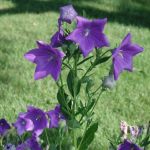| Common Name: |
Balloon Flower |
| Other Names: |
Chinese bellflower |
| Botanical Name: |
Platycodon grandiflorus |
| Genus: |
Platycodon |
| Family: |
Campanulaceae |
| Native Location: |
N China, Japan, Korea, and Russia (E Siberia) |
| Cultivation: |
Rich, moise, well-drained, sandy soil in sun. Seedlings are very fragile and best planted out when dormant. |
| Propagation: |
By seed sown in spring; by division in summer; by separating rooted basal shoots in early summer. |
| Harvest: |
Roots are lifted in spring or autumn from plants 2-3 years old, peeled, and used fresh, or dried for decoctions and powders. |
| Variations: |
var. albus
Has white flowers. |
Apoyama
syn. var. apoyama
Is dwarf, with larger, deeper blue flowers.
Height: 20cm (8in) |
Perlmutterschale
syn. Mother of Pearl
Has pale pink flowers. |
|
| Height: |
40-90cm (16-36in) |
| Width: |
30cm (12in) |
| Hardiness: |
Z3-8 |
| Parts Used: |
Roots (jie geng) |
| Properties: |
A bitter, pungent, warming herb that dilates the bronchial vessels; it is expectorant and effective against a number of disease causing organisms. |
| Medicinal Uses: |
Internally for coughs with profuse phlegm, colds, bronchitis, pleurisy, pulmonary abscess, and throat infections. Combined with Glycyrrhiza uralensis (See, Chinese Licorice) for throat infections. |
| Culinary Uses: |
Roots are eaten raw in salads, added to tonic soups, pickled, or preserved in sugar; also one of the seven herbs used to flavor Japanese sake. |
| Bibliography: |
Encyclopedia of Herbs by Deni Brown Copyright © 1995, 2001 Dorling Kindersley Limited Pp 323-324 |

